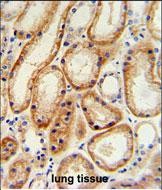GALNT5 Antibody (N-term)
Affinity Purified Rabbit Polyclonal Antibody (Pab)
- SPECIFICATION
- CITATIONS: 1
- PROTOCOLS
- BACKGROUND

Application
| WB, FC, IHC-P, E |
|---|---|
| Primary Accession | Q7Z7M9 |
| Reactivity | Human |
| Host | Rabbit |
| Clonality | Polyclonal |
| Isotype | Rabbit IgG |
| Calculated MW | 106266 Da |
| Antigen Region | 24-53 aa |
| Gene ID | 11227 |
|---|---|
| Other Names | Polypeptide N-acetylgalactosaminyltransferase 5, Polypeptide GalNAc transferase 5, GalNAc-T5, pp-GaNTase 5, Protein-UDP acetylgalactosaminyltransferase 5, UDP-GalNAc:polypeptide N-acetylgalactosaminyltransferase 5, GALNT5 |
| Target/Specificity | This GALNT5 antibody is generated from rabbits immunized with a KLH conjugated synthetic peptide between 24-53 amino acids from the N-terminal region of human GALNT5. |
| Dilution | WB~~1:1000 FC~~1:10~50 IHC-P~~1:50~100 E~~Use at an assay dependent concentration. |
| Format | Purified polyclonal antibody supplied in PBS with 0.09% (W/V) sodium azide. This antibody is purified through a protein A column, followed by peptide affinity purification. |
| Storage | Maintain refrigerated at 2-8°C for up to 2 weeks. For long term storage store at -20°C in small aliquots to prevent freeze-thaw cycles. |
| Precautions | GALNT5 Antibody (N-term) is for research use only and not for use in diagnostic or therapeutic procedures. |
| Name | GALNT5 |
|---|---|
| Function | Catalyzes the initial reaction in O-linked oligosaccharide biosynthesis, the transfer of an N-acetyl-D-galactosamine residue to a serine or threonine residue on the protein receptor. Has activity toward EA2 peptide substrate, but has a weak activity toward Muc2 or Muc1b substrates (By similarity). |
| Cellular Location | Golgi apparatus membrane; Single- pass type II membrane protein |

Provided below are standard protocols that you may find useful for product applications.
Background
GALNT5 can catalyze the initial reaction in O-linked oligosaccharide biosynthesis,the transfer of an N-acetyl-D-galactosamine residue to a serine or threonine residue on the protein receptor. GALNT5 has activity toward EA2 peptide substrate, but it has a weak activity toward Muc2 or Muc1b substrates.
References
Simmons, A.D., et al. Hum. Mol. Genet. 8(12):2155-2164(1999)
If you have used an Abcepta product and would like to share how it has performed, please click on the "Submit Review" button and provide the requested information. Our staff will examine and post your review and contact you if needed.
If you have any additional inquiries please email technical services at tech@abcepta.com.














 Foundational characteristics of cancer include proliferation, angiogenesis, migration, evasion of apoptosis, and cellular immortality. Find key markers for these cellular processes and antibodies to detect them.
Foundational characteristics of cancer include proliferation, angiogenesis, migration, evasion of apoptosis, and cellular immortality. Find key markers for these cellular processes and antibodies to detect them. The SUMOplot™ Analysis Program predicts and scores sumoylation sites in your protein. SUMOylation is a post-translational modification involved in various cellular processes, such as nuclear-cytosolic transport, transcriptional regulation, apoptosis, protein stability, response to stress, and progression through the cell cycle.
The SUMOplot™ Analysis Program predicts and scores sumoylation sites in your protein. SUMOylation is a post-translational modification involved in various cellular processes, such as nuclear-cytosolic transport, transcriptional regulation, apoptosis, protein stability, response to stress, and progression through the cell cycle. The Autophagy Receptor Motif Plotter predicts and scores autophagy receptor binding sites in your protein. Identifying proteins connected to this pathway is critical to understanding the role of autophagy in physiological as well as pathological processes such as development, differentiation, neurodegenerative diseases, stress, infection, and cancer.
The Autophagy Receptor Motif Plotter predicts and scores autophagy receptor binding sites in your protein. Identifying proteins connected to this pathway is critical to understanding the role of autophagy in physiological as well as pathological processes such as development, differentiation, neurodegenerative diseases, stress, infection, and cancer.



